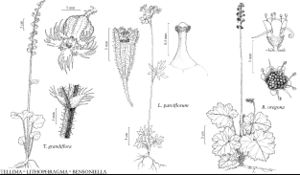Difference between revisions of "Tellima grandiflora"
Bot. Reg. 14: plate 1178. 1828,.
FNA>Volume Importer |
FNA>Volume Importer |
(No difference)
| |
Revision as of 23:01, 16 December 2019
Leaves: stipules sheathing, greenish, ca. 5 mm, membranous; petiole 3–30 cm; blade 3.5–10 cm, ultimate margins ciliate. Inflorescences 40–90 cm, densely stipitate-glandular or glandular-hispid; bracts subtending pedicels scalelike. Flowers: hypanthium campanulate to widely urceolate, 4.5–9 mm, stipitate-glandular; sepals erect, elliptic, 1–3 mm, apex acute; petals erect proximally, spreading to reflexed distally, obovate, 5–7-lobed, 3–7 mm, lobes usually linear; stamens included, 0.8–1 mm; filaments 0.5 mm; styles included, 1–1.5 mm. Capsules ovoid, 7–8 mm. Seeds 100–150, 0.8–1 mm. 2n = 14.
Phenology: Flowering Apr–Jul.
Habitat: Moist forests, thickets, meadows, rocky slopes, often near streams
Elevation: 0-2000 m
Distribution

B.C., Alaska, Calif., Idaho, Mont., Oreg., Wash.
Discussion
Tellima grandiflora is found in moist, shaded sites from Alaska and British Columbia to California south of San Francisco. It resembles species of Mitella in its finely pinnatifid petals but is distinguished from most of them by the two to three conspicuous, alternate, cauline leaves in Tellima. It is distinguished from M. caulescens by the latter’s basipetalous anthesis.
Selected References
None.
